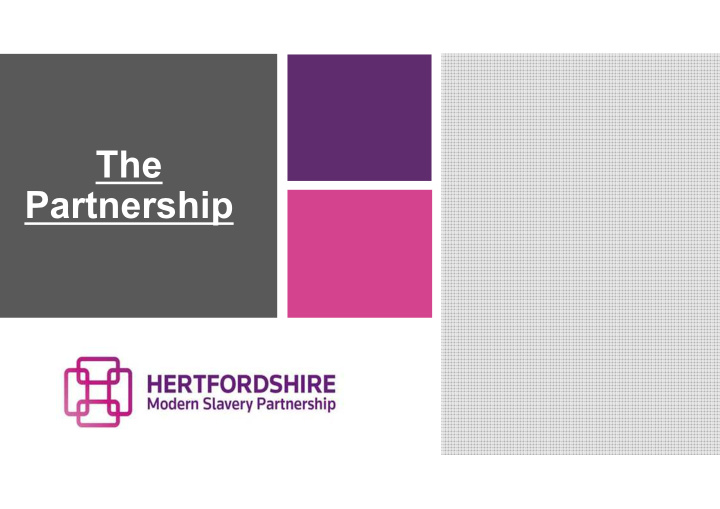



The Partnership
Raise awareness Strategic of HTMS and its Priority 1 effects
HMSP CELEBRATION EVENT – 15/10/18 Total Attendees: 75 Local : District/Borough Councils, Police, Beacon, NHS Turnout: 91% Trusts, OPCC, Herts FRS, High Sheriff, St Albans Organisations Diocese Represented: 43 (50-50 local/national split) National: ODLME, Office of the IASC, Welsh Government, UK Parliament and Lords, Commonwealth Parliamentary Association-UK, Home Office, Bulgarian Embassy, IOM, LGA
Increase Reporting of Strategic Priority 2 Suspected HTMS
Ensure Right Strategic Knowledge, Priority 3 Skills and Process
Support, Protect and Strategic Priority 4 Empower Victims
Pursue and Catch Strategic Priority 5 Criminals
Effective Governance, Strategic Monitoring and Priority 6 Evaluation
Challenges • Many victims face destitution and homelessness after being identified. • Many victims are at a high risk of being exploited or forced into prostitution to meet basic needs. • Children victims are also more likely to go missing from care and return to exploitation. In fact, at least 40% of victims will be re-trafficked.
Example Option Possible Actions The council agreed to provide accommodation and 1 subsistence-level financial support. 2 The council refused to provide accommodation and subsistence-level financial support, but referred the woman onto services that can help her. 3 The council refused to provide accommodation and subsistence-level financial support, and closes the case with no signposting or support.
Example Option Possible Actions Possible Outcomes The council agreed to provide The woman manages to begin to turn her life 1 accommodation and subsistence-level around and begin to look for work. financial support. The council refused to provide The woman manages to find housing through 2 accommodation and subsistence-level the specialist service but cannot meet her financial support, but referred the woman most basic needs so is forced to re-engage in onto services that can help her. prostitution. 3 The council refused to provide The woman has no means of supporting accommodation and subsistence-level herself or returning to her country of origin, financial support, and closes the case with no support network and faces destitution and no signposting or support. homelessness. She is forced to reengage in prostitution.
International Legal Obligations • Articles 3 & 4 of the European Convention on Human Rights • Article 12 of the Convention against Trafficking • Article 11 of the EU Anti-Trafficking Directive
How do We Tackle HTMS • Awareness and consistency • Data recording and monitoring • Responsibilities to adult victims • Specialist knowledge • Measures to tackle modern slavery in supply chains
Supply Chain Challenges in 2018 An estimated 24.9 million people were victims of forced labour in 2016 16 million people of those were in the private economy i.e. within organisation supply chains This means that they were being forced to work under threat or coercion on construction sites, in factories, on farms and fishing boats They were forced to work by private individuals and groups or by state authorities. In many cases, the products they made and the services they provided ended up in seemingly legitimate commercial channels . International Labour Office Figures 2017
Commitment and Change • Production of a compliant modern slavery statement • Sign up to MS Charter • Staff training • Greater responsibility for victims • A designated person/s to take responsibility for exploitation • An internal strategic lead for exploitation
Thank you & Questions
Recommend
More recommend